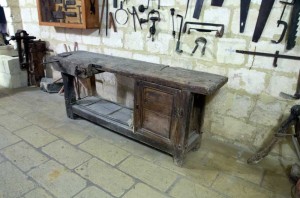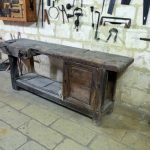We may receive a commission when you use our affiliate links. However, this does not impact our recommendations.
Finding a French-style workbench with a twin-screw vise is somewhat uncommon. And so what furniture maker Nick Webb stumbled upon on the Mediterranean island of Gozo is even more unusual.
The bench is in the carpenter’s shop of the Ta’ Kola Windmill, an 18th-century structure on the island. The bones of the bench are fairly typical for an Old World workbench. But the face vise is the real show stealer. It is, in essence, a leg vise that has been rotated 90°. The vise’s parallel guide is a piece of iron or steel that is strapped to the benchtop and pierces the chop of the face vise.
With a vise like this, the pin goes on the outside of the chop to make the chop pivot and grab your work. That’s because the parallel guide is fixed to the benchtop and front leg instead of the chop. It is simply backward from the arrangement of a traditional leg vise.
Other interesting details of the bench:
1. It clearly had a wooden planing stop common on old benches, though I can’t see if it’s still in its hole and if it has an iron bench hook in it or not.
2. The top is made up of two pieces of timber and it looks like there is some piece of iron strapping across the seam. I wonder if this is a later addition to the benchtop or is original.
3. The bench’s base is secured with bolts. This is feature typical of 19th-century benches and later, though I wouldn’t use this detail to definitively date the bench.
4. The cabinet on the right side of the bench is something I see fairly often on these old workbenches, both in Europe and in French Canadian workbenches. If you don’t have an end vise that would interfere with the cabinet, it’s a generally swell idea.
The small decorative details on this bench are nice – not overwhelming. I like the full bead on the end of the metal parallel guide. The vise’s chop has a nice cove on one end. And the front left leg has an hourglass shape – at least that’s what I think I’m seeing.
Thanks to Nick for photographing this bench and sharing it with with us.
— Christopher Schwarz
Need more material on workbenches? This blog has seven years of my writing on workbenches. All here. All free. Click here to get started.
Or check out my books on building workbenches at shopwoodworking.com
We have a lot of books and DVDs on workbenches in ShopWoodworking – including downloads of my first two books on the topic at a special price. Plus a DVD that follows me as a I build an 18th-century Roubo bench by hand.
Here are some supplies and tools we find essential in our everyday work around the shop. We may receive a commission from sales referred by our links; however, we have carefully selected these products for their usefulness and quality.















The work is clamped to the left of the guide, I believe. Given where the screw is, a tremendous mechanical advantage is achieved much more than a traditional leg vise. What was the bench used for?
Brian
I saw a drawing of a English workbench with a vice very similar except the guide was perpendicular to the bench top.
I also wonder why he fixed the guide to the bench top rather than taking it down the face of the leg. Or better still, through the leg and then attached to the underside of the top.
Chris,
I can confirm that the leg is hourglass shaped.
I like the detail of the metal garter round the mortice for the parallel guide in the chop.
Interesting bench/vise. It’s so cool to see the infinite variations configuration of common bench appliances. It would make me nervous to have all that exposed iron near so close to the business end of sharp tools. I wonder what the function of the iron strap that comes up over the benchtop (a repair?).
Still plenty of clamping room, even with the cabinet.
That face vise is pretty wacky though, but I’ll bet it works well enough. I could just see my self clipping my side with the chunk of iron hanging out in the air like that.
Badger